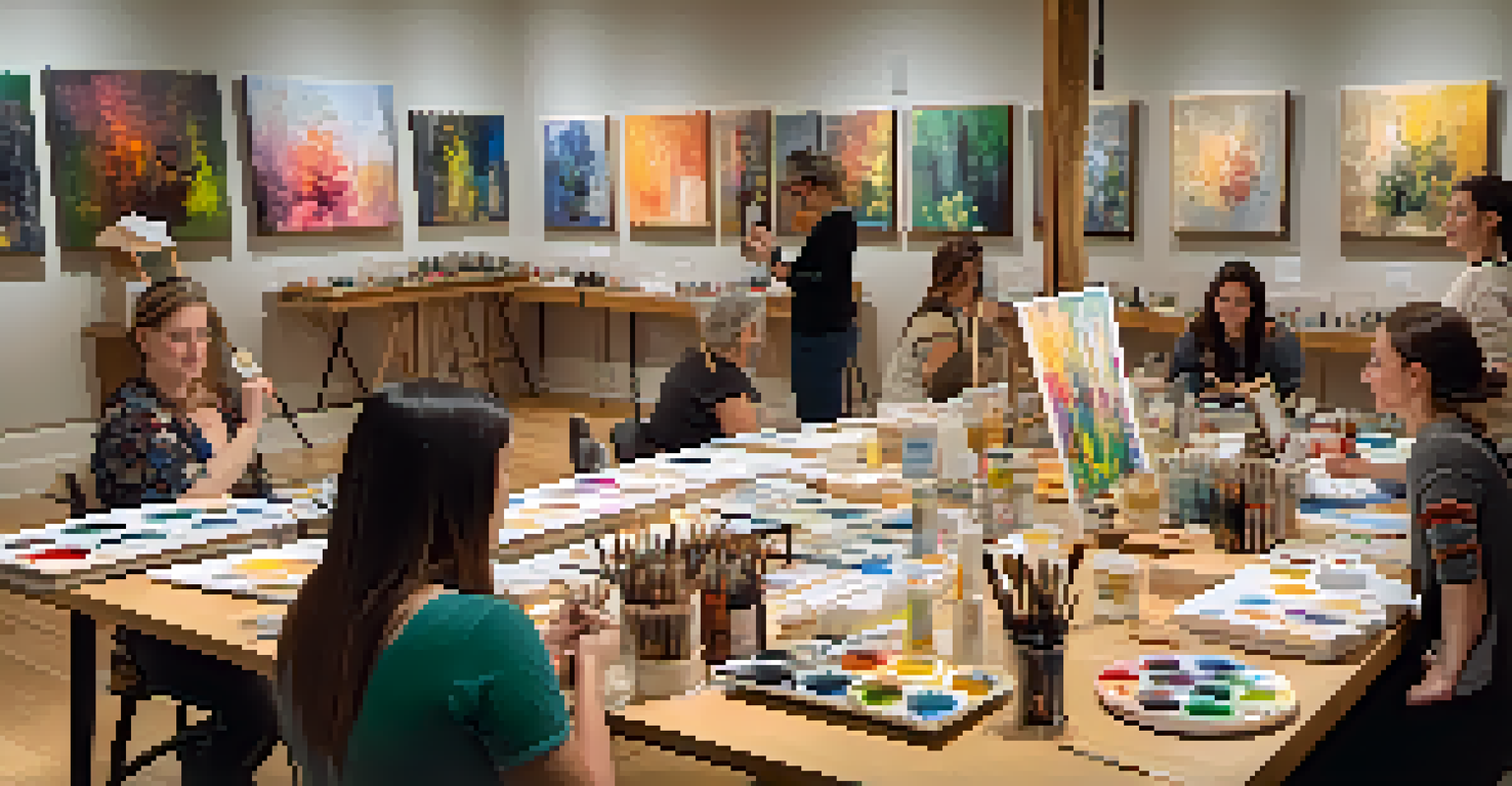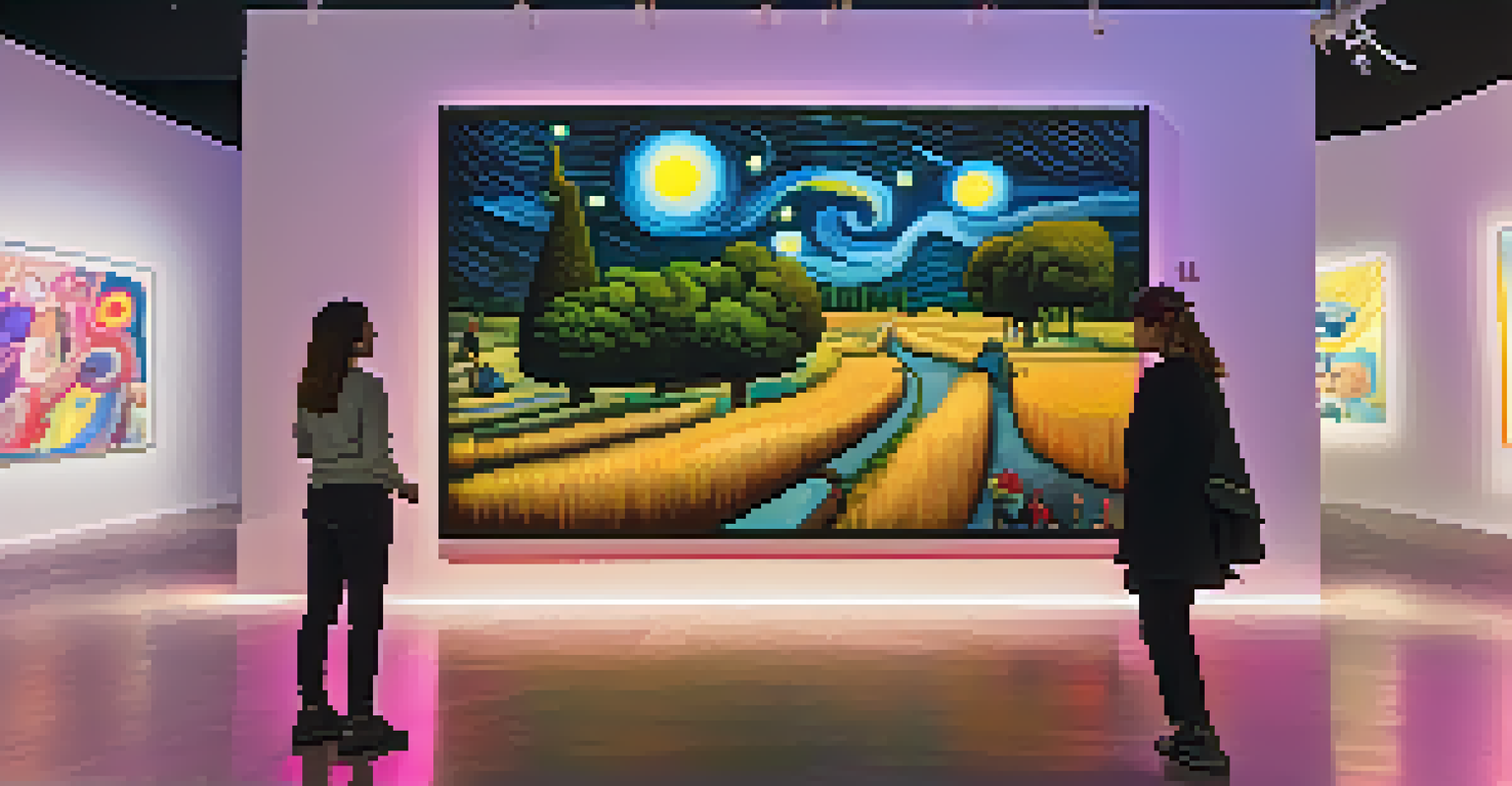The Influence of Museums on Public Perception of Painting

Museums as Gatekeepers of Artistic Value
Museums play a crucial role in determining what art is deemed valuable and worthy of public attention. They curate collections that highlight certain styles, periods, and artists, influencing how we perceive and appreciate painting. For example, when a museum showcases a specific movement, like Impressionism, it not only educates the public but also elevates that style's status in the art world.
Museums are not just places to preserve art; they are places to engage with it, to understand it, and to allow it to speak to us in new ways.
This curation often reflects broader cultural narratives and societal values, which means that what we see in museums can shape our understanding of art history. Visitors might leave with an impression that certain artists are more important than others simply because of their presence in a well-respected institution. This selective representation can lead to a skewed perception of what constitutes 'great' or 'important' painting.
Moreover, as museums continue to adapt their exhibitions to include diverse voices, they challenge traditional notions of artistic merit. This evolution not only enriches public perception but also opens the door for a wider array of artistic expressions to gain recognition.
The Role of Educational Programs in Museums
Museums often host educational programs that deepen visitors' understanding of painting, making art more accessible. Through workshops, lectures, and guided tours, these institutions provide context that helps demystify complex artworks. For instance, a painting that may seem abstract at first glance can become more meaningful when its historical background is explained.

These programs encourage active engagement with art, transforming passive viewing into an interactive experience. When visitors learn about the techniques and intentions behind a painting, they are more likely to develop a personal connection to the artwork. This hands-on approach can foster a greater appreciation for not just paintings, but the entire artistic process.
Museums Shape Artistic Value
Through curation and exhibitions, museums influence public perception of art by elevating certain styles and artists.
Additionally, educational initiatives can inspire a new generation of artists and art enthusiasts. When people feel empowered to explore their creativity and understand art's significance, they often carry that passion beyond the museum walls.
Exhibitions: Shaping Trends and Preferences
Temporary exhibitions are a powerful tool for influencing public perception of painting. By spotlighting specific artists or themes, museums can create trends that resonate with audiences. For example, a retrospective of a contemporary artist can lead to a surge in popularity for their work and similar styles, shaping what is perceived as 'in vogue' in the art community.
Art is not what you see, but what you make others see.
These exhibitions not only highlight the work of established artists but also provide a platform for emerging talents. By showcasing new perspectives, museums help diversify the narratives surrounding painting and promote varied artistic expressions. This can lead to shifts in public taste and a broader understanding of what constitutes contemporary art.
Furthermore, the marketing of these exhibitions often plays a crucial role in attracting visitors. Engaging promotional materials and social media campaigns can generate buzz, transforming how certain artworks are viewed and appreciated by the public.
Social Media: A New Museum Space
In today's digital age, social media has become a crucial extension of the museum experience, influencing public perceptions of painting. Platforms like Instagram allow museums to showcase their collections to a global audience, often transforming the way art is consumed and appreciated. A single post can spark interest in a lesser-known painting, giving it newfound visibility.
This online presence invites dialogue and interaction, as users can share their interpretations and engage with others. The democratization of art appreciation through social media means that everyone's opinion can contribute to the larger conversation about painting, shifting traditional power dynamics in the art world.
Education Enhances Art Engagement
Educational programs in museums transform art viewing into interactive experiences, fostering deeper connections to painting.
However, this trend also poses challenges, as artworks can be reduced to mere visuals, often stripped of their context. Museums must navigate this landscape carefully, ensuring that while they capitalize on social media's reach, they also maintain the depth of understanding that comes from the physical museum experience.
The Influence of Art Criticism and Reviews
Art criticism plays a significant role in shaping how the public perceives paintings and artists. Reviews and critiques published in newspapers, magazines, or online platforms can influence visitor numbers and the general appreciation of an exhibition. A well-regarded critic's praise of a particular painting can elevate its status and draw more attention to it, while negative reviews can have the opposite effect.
Critics analyze artworks based on various criteria, including technique, emotional impact, and cultural relevance. This analysis can help audiences understand complex concepts and appreciate the subtleties of painting that might otherwise go unnoticed. For example, a critique may highlight an artist’s innovative use of color, prompting viewers to look more closely at that aspect during their visit.
Moreover, the rise of online platforms has democratized art criticism, allowing more voices to contribute to the conversation. This shift means that public perception is now influenced by a wider array of opinions, fostering a richer dialogue around painting and its significance.
Community Engagement: Museums as Cultural Hubs
Museums increasingly function as community centers, fostering connections between art and local culture. By hosting events, workshops, and exhibitions that reflect the community's identity, museums help cultivate a sense of belonging and pride. This engagement not only enhances public perception of painting but also encourages community members to see themselves as part of the artistic narrative.
Collaborative projects between museums and local artists can result in unique exhibitions that resonate with the local audience. For instance, a community mural project can highlight the cultural heritage of a neighborhood, showcasing how painting is intertwined with identity and history. Such initiatives make art more relatable and relevant to people's lives.
Social Media Redefines Art Access
Social media extends the reach of museums, democratizing art appreciation while presenting challenges in maintaining depth of context.
Furthermore, when museums prioritize inclusivity and representation, they broaden the scope of what art is celebrated. This approach not only enhances public perception but also invites diverse voices into the conversation, enriching the overall understanding of painting.
The Future of Museums and Painting Perception
As museums continue to evolve, their influence on public perception of painting will likely grow. With advancements in technology and changing societal values, museums are exploring innovative ways to engage audiences. Virtual reality experiences, for example, can immerse visitors in a painting, allowing them to explore its details in ways that were previously unimaginable.
Additionally, the trend toward more inclusive and diverse exhibitions suggests a future where a broader range of artistic voices are recognized. This shift not only enhances public perception but can also inspire new generations of artists to express themselves authentically. The conversation around painting is becoming more inclusive, reflecting the diversity of experiences in our society.

Ultimately, as museums adapt to contemporary audiences, they will continue to shape how we perceive and appreciate paintings, ensuring that art remains a vital part of our cultural landscape.